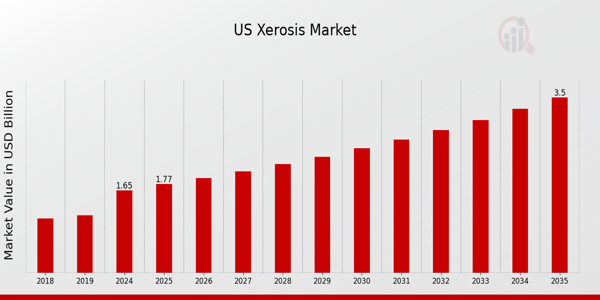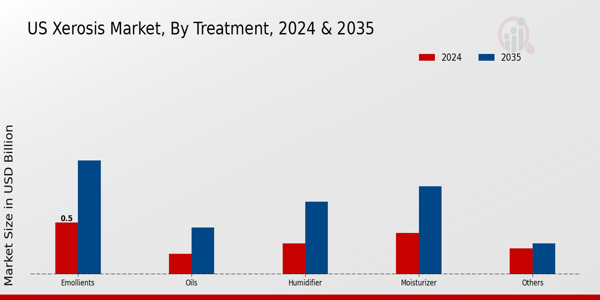US Xerosis Market Overview
As per MRFR analysis, the US Xerosis Market Size was estimated at 1.51 (USD Billion) in 2023. The US Xerosis Market Industry is expected to grow from 1.65(USD Billion) in 2024 to 3.5 (USD Billion) by 2035. The US Xerosis Market CAGR (growth rate) is expected to be around 7.075% during the forecast period (2025 - 2035).
Key US Xerosis Market Trends Highlighted
The US Xerosis Market is experiencing significant trends driven by a growing awareness of skin health issues and increasing incidence of dry skin conditions due to environmental factors. The rise in cases of xerosis is largely attributed to factors such as environmental changes, lifestyle shifts, and increased air pollution, which have been reported to exacerbate skin dryness.
Additionally, the aging population in the US is another key market driver, as older adults are more prone to skin dryness due to natural changes in skin elasticity and moisture retention. There are also numerous opportunities to be explored in the market, such as the expansion of product offerings catering to dry skin.
Companies are focusing on developing moisturizers, emollients, and high-quality dermatological treatments specifically designed for xerosis. There is potential for innovative product formulations that incorporate natural ingredients, appealing to consumers seeking safer and more effective solutions. Recent trends in the US include the increasing consumer preference for over-the-counter solutions and a growing inclination toward herbal and organic skincare products.
Public health campaigns focused on skin awareness have contributed to the rising demand for products targeting xerosis, leading to heightened visibility in retail settings and online platforms. Moreover, teledermatology is gaining traction, allowing patients to seek professional advice for skin conditions conveniently. Overall, the combined effect of these factors is driving growth in the US Xerosis Market and highlighting the need for continuous innovation and consumer education.

Source: Primary Research, Secondary Research, Market Research Future Database and Analyst Review
US Xerosis Market Drivers
Rising Incidence of Xerosis Due to Aging Population
The increasing prevalence of xerosis, commonly known as dry skin, is significantly influenced by the aging population in the United States. According to the Administration on Aging, it is projected that by 2030, approximately 20% of the U.S. population will be over 65 years old, a group that is particularly susceptible to developing xerosis.
The aging skin loses moisture more quickly, leading to dryness and irritation. This demographic shift is driving greater demand for dermatological products and treatment therapies catering to xerosis. Well-established organizations like the American Academy of Dermatology are actively providing educational resources and initiatives aimed at managing skin conditions in older adults, further underpinning the growth of the US Xerosis Market Industry as products designed for this population segment become increasingly relevant and in demand.
Increased Awareness and Diagnosis of Dermatological Conditions
There is a growing awareness regarding skin health and dermatological conditions, which has led to an increase in diagnoses, including xerosis. Public health campaigns by institutions such as the Centers for Disease Control and Prevention (CDC) emphasize the importance of recognizing skin issues early and seeking treatment.
With long-standing statistics indicating over 80 million Americans visit a dermatologist each year for skin-related concerns, it's evident that there is a substantial market for products targeting xerosis. This heightened awareness facilitates an expansion in the US Xerosis Market Industry, as healthcare providers increasingly prescribe moisturizers and topical treatments, stimulating revenue growth.
Advancements in Moisturizing Treatments and Products
The development of innovative moisturizing products and treatments is a key driver of the US Xerosis Market Industry. Research and Development in formulations that specifically target hydration and skin barrier restoration has led to a rise in effective solutions for individuals suffering from xerosis.
For instance, organizations like the National Institutes of Health (NIH) have been instrumental in funding research projects aimed at exploring new ingredients and technologies for skin hydration. This has resulted in a broader array of products available, from prescription therapies to over-the-counter solutions, thus enhancing consumer options and driving market growth in the xerosis segment.
US Xerosis Market Segment Insights
Xerosis Market Treatment Insights
The Treatment segment of the US Xerosis Market is a critical area driven by the prevalence of dry skin conditions in the population, with millions of Americans experiencing xerosis annually. With the overall market for Xerosis expected to reach 1.65 billion USD by 2024, the Treatment segment plays a significant role in addressing the skin hydration needs of these individuals.
The US Xerosis Market revenue reflects a variety of treatment options aimed at alleviating symptoms and improving skin health. Within this segment, products such as emollients and moisturizers are essential, as they work to create a protective barrier on the skin, locking in moisture and providing relief from dryness. The growing consumer awareness about skincare and increasing preference for natural ingredients are propelling the demand for moisturizers significantly in the US Xerosis Market industry.
Humidifiers also become crucial, especially in arid climates or during winter seasons, where dry air can exacerbate the condition of the skin, thereby enhancing the treatment landscape. Oils, categorized under the Treatment segment, are increasingly recognized for their hydrating properties and ability to nourish and soothe the skin, appealing particularly to consumers seeking natural and organic solutions.
Furthermore, the diverse range of options available within the Treatment segment allows healthcare providers and consumers to select tailored solutions based on individual skin needs. The growth of digital health and telemedicine services has been instrumental in improving access to dermatological care, encouraging consumers to seek professional advice on appropriate treatments. This has resulted in an uptick in the use of combination therapies for xerosis, maximizing treatment effectiveness while addressing various sub-types of dryness.
The penetration of e-commerce platforms has also enabled broader reach, making these Treatment options easily accessible even in remote areas. Increasingly, the US Xerosis Market segmentation is expected to grow, with treatment solutions designed to improve quality of life for individuals dealing with this chronic condition, showcasing a steady evolution in response to consumer needs and trends. In essence, the Treatment segment is pivotal in shaping the landscape of the US Xerosis Market, emphasizing the importance of proper skin hydration and care, ultimately improving the overall wellbeing of those affected by xerosis.

Source: Primary Research, Secondary Research, Market Research Future Database and Analyst Review
Xerosis Market Causes Insights
The US Xerosis Market is significantly influenced by various causes, which encompass a range of skin conditions and health issues. Among these, eczema and psoriasis are notably prevalent, often leading to chronic dry skin conditions, thus contributing significantly to the Xerosis landscape.
The aging population also plays a critical role, as skin naturally loses moisture and elasticity over time, making elderly individuals more susceptible to Xerosis. Furthermore, underlying health conditions such as diabetes and hypothyroidism exacerbate skin dryness, revealing a complex interplay between systemic health and dermatological symptoms.
In recent years, increased awareness and diagnosis of these skin conditions have driven market dynamics, leading to a surge in demand for specialized products and treatments aimed at alleviating dry skin symptoms. The emphasis on Research and Development in pharmaceuticals and dermatological products is also notable, as innovative therapies offer new solutions for patients. Overall, the addressing of these diverse causes within the US Xerosis Market is vital for understanding the broader market dynamics and consumer needs.
Xerosis Market End Users Insights
The US Xerosis Market revenue reflects a growing landscape focused on various end users, including hospitals, dermatology clinics, and home care settings. Each of these entities plays a crucial role in addressing the challenges posed by xerosis, significantly impacting patient care and treatment outcomes.
Hospitals are key providers of acute medical care, often equipped with advanced technology and professionals who specialize in skin conditions, thus addressing severe cases of xerosis effectively. Dermatology clinics, on the other hand, provide specialized services tailored to skin health, emphasizing preventive care and chronic management, which is essential for maintaining skin integrity and patient comfort.
Home care settings have gained prominence as they offer patients convenience and personalized care, enabling them to manage their condition in a familiar environment. The demand for effective treatments in these settings is continually driven by an increasing awareness of skin health and expanding aging populations in the United States. Overall, the combination of these end users reflects significant opportunities for growth and advancements in managing xerosis conditions across various demographics.
US Xerosis Market Key Players and Competitive Insights
The competitive landscape of the US Xerosis Market is shaped by a range of factors, including an increasing prevalence of dry skin conditions, growing awareness about skin health, and the demand for effective treatment solutions. Various companies are striving to establish their presence in this market by introducing novel products, enhancing their formulations, and expanding their distribution channels.
The market is characterized by both established pharmaceutical companies and newer entrants focusing on dermatological products, thus intensifying competition. Innovations in formulations and a focus on natural ingredients also play a significant role in differentiating products among competitors. Companies are leveraging robust marketing strategies and consumer education to promote their offerings, supporting market growth and increased consumer engagement.
Novartis has carved a notable position in the US Xerosis Market, highlighting its strengths in innovation and research-driven product development. The company is recognized for its commitment to delivering high-quality dermatological solutions tailored to address xerosis-related skin ailments effectively. Through its strong portfolio, Novartis emphasizes integrating advanced technology and clinical insights to ensure the effectiveness and safety of its products.
By focusing on patient-centric approaches, Novartis has fostered trust among its clientele, which is crucial for sustaining its competitive edge in the market. The company's significant investments in R&D and strategic partnerships further enhance its capabilities in offering comprehensive treatment options, positioning it favorably in a competitive environment.
Eucerin enjoys a prominent reputation in the US Xerosis Market, catering specifically to consumers seeking effective skincare solutions for dry skin conditions. The brand is well-known for its key products, including advanced moisturizing creams and lotions that address various levels of xerosis. Eucerin's strength lies in its strong market presence and the trust it has built with consumers over the years through proven efficacy.
The company is recognized for its commitment to dermatological research, leading to consistent innovations in its product lineup. A robust network of distribution channels ensures the availability of its products across retail and online platforms, enhancing its accessibility to consumers. Moreover, Eucerin has engaged in strategic partnerships and collaborations that bolster its innovation capabilities and enhance its market reach, reflecting its commitment to being a leader in the skincare sector within the US.
Through these efforts, Eucerin continues to maintain a competitive stance, focusing on the evolving needs of its target audience while ensuring the delivery of reliable and effective solutions for xerosis.
Key Companies in the US Xerosis Market Include
- Novartis
- Eucerin
- GlaxoSmithKline
- Eli Lilly
- Procter and Gamble
- Aveeno
- CeraVe
- Dermavant Sciences
- Humboldt Therapeutics
- Amgen
- Allergan
- Sanofi
- Johnson and Johnson
- Mylan
- Bayer
US Xerosis Market Industry Developments
The US Xerosis Market has seen notable recent developments and growth dynamics, particularly with companies such as Novartis, Eucerin, GlaxoSmithKline, and Eli Lilly making headlines. Procter and Gamble and Aveeno announced new product launches targeting xerosis, while CeraVe, Dermavant Sciences, and Humboldt Therapeutics continued to expand their therapeutic offerings.
In a significant merger, Allergan finalized a strategic acquisition of a skin care line in June 2023, reflecting consolidation trends in the market. Meanwhile, Amgen and Johnson and Johnson reported advancements in their xerosis-related treatments, contributing to an increasing market valuation. The most recent data indicates a surge in the demand for moisturizers and topical treatments, indicating a sustained interest in xerosis solutions.
Additionally, regulatory changes in August 2023 have improved the approval processes for new dermatological treatments, benefiting companies like Bayer and Mylan. Over the past couple of years, the market has evolved significantly as companies invest in Research and Development to innovate solutions for xerosis, indicating a vibrant and competitive landscape focused on improving patient care in the US.
US Xerosis Market Segmentation Insights
Xerosis Market Treatment Outlook
- emollients
- moisturizer
- humidifier
- oils
- others
Xerosis Market Causes Outlook
- eczema
- psoriasis
- diabetes
- hypothyroidism
- aging
- others
Xerosis Market End Users Outlook
- hospitals
- dermatology clinics
- home care
| Report Attribute/Metric Source: |
Details |
| MARKET SIZE 2018 |
1.51(USD Billion) |
| MARKET SIZE 2024 |
1.65(USD Billion) |
| MARKET SIZE 2035 |
3.5(USD Billion) |
| COMPOUND ANNUAL GROWTH RATE (CAGR) |
7.075% (2025 - 2035) |
| REPORT COVERAGE |
Revenue Forecast, Competitive Landscape, Growth Factors, and Trends |
| BASE YEAR |
2024 |
| MARKET FORECAST PERIOD |
2025 - 2035 |
| HISTORICAL DATA |
2019 - 2024 |
| MARKET FORECAST UNITS |
USD Billion |
| KEY COMPANIES PROFILED |
Novartis, Eucerin, GlaxoSmithKline, Eli Lilly, Procter and Gamble, Aveeno, CeraVe, Dermavant Sciences, Humboldt Therapeutics, Amgen, Allergan, Sanofi, Johnson and Johnson, Mylan, Bayer |
| SEGMENTS COVERED |
Treatment, Causes, End Users |
| KEY MARKET OPPORTUNITIES |
Increased demand for natural remedies, Growth in telehealth services, Rising awareness of skin health, Innovative product formulations, Expansion of e-commerce channels |
| KEY MARKET DYNAMICS |
aging population, rising prevalence, increasing awareness, innovative treatments, regulatory advancements |
| COUNTRIES COVERED |
US |
Frequently Asked Questions (FAQ):
The US Xerosis Market is expected to be valued at 1.65 billion USD in 2024.
By 2035, the US Xerosis Market is projected to reach a value of 3.5 billion USD.
The expected CAGR for the US Xerosis Market from 2025 to 2035 is 7.075%.
Key players in the US Xerosis Market include Novartis, Eucerin, GlaxoSmithKline, and Eli Lilly among others.
The market value for emollients in the US Xerosis Market is anticipated to be 1.1 billion USD by 2035.
The moisturizer segment is expected to grow to 0.85 billion USD by 2035.
The projected market size for humidifiers in the US Xerosis Market is estimated to be 0.7 billion USD by 2035.
The oils segment is expected to be valued at 0.45 billion USD in 2035.
The 'others' treatment segment is anticipated to reach a market size of 0.3 billion USD by 2035.
Emerging trends such as increased awareness about skin health and the rising availability of advanced treatment options are driving growth.
















